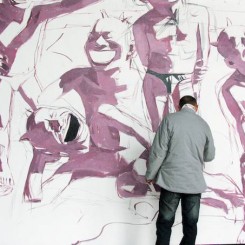IW: So you mean you have attained what you had aimed for, as an artist — the peak of your development?
YM: But there is no end. It’s a difficult question.
IW: What is the shape of your ambition now?
YM: It is not finished; there is still work to be done.
IW: Your works also imply the role of the artist in relation to the society of which he is a part, its sensations and issues. How do you see yourself in this light? Is your work the product of a certain distance, or of an intensely subjective view?
YM: I think that looking from a distance is more appropriate to describe my position, and that it is related to my character. I feel myself to be more of an observer.
IW: There is a very clear thematic path throughout your oeuvre — a steady line and a consistent, recurring image. Do you think that if you were to begin as an artist now, it would be the same?
YM: I really don’t know! Maybe, as part of the development of society, art has developed a lot. For artists, there are different requirements and status. At the time when I started working, artists needed more power; they felt very small in society at that time, and that they needed to express their power by the force of repetition and with a definitive image in order to be stronger and get noticed. Now, it is hard to say, and I am not a young artist.
IW: Are you much in touch with young artists now?
YM: Quite seldom. It is a form of self-protection, also, to avoid too much contact with other artists which might affect your work. For some artists, communication and discussion is what is needed; but if you are working on a single idea, it is necessary to think deeply and bring it to full realization.
IW: What is your attitude to the audience? When you are working, are you conscious of their reactions? Is this part of your process?
YM: When you create an art work, you cannot consider the audience too much; it isn’t like film, where you must communicate. The preciousness of painting is that everyone can have a dream. When you create a painting, the audience sometimes appears, and sometimes disappears. But when you present the work in an exhibition, the reaction of the audience may give you new inspiration.
IW: Do you have any examples of this from the Cartier exhibition?
YM: After seeing the exhibition, someone said to me that they felt there was a kind of absence in my paintings. For example, the Landscape without People series — when I painted this series, I didn’t think about that.
IW: It has occurred to me that your work is about presence and absence, simultaneously.
YM: This absence is perhaps related to my pessimism. These reactions by others allow me to rethink myself and my character.
IW: I was just looking at the sculpture over there. When you are around these works, even having created them yourself, are you conscious of a feeling they impart to you, or are they simply there as products?



